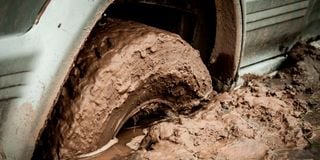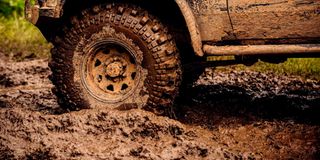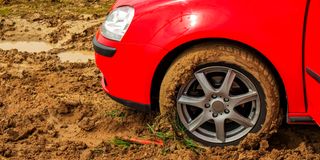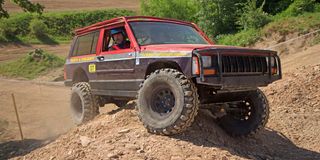Premium
Treading carefully: A look at the most suitable tyres for Kenya’s roads

One of the most extreme examples of a mud-grip tyre is fitted to tractors. The tread consists of a few but very large (both tall and thick) “blades” of rubber.
The part of the tyre most vulnerable to damage on uneven and often sharp cobbles or tooth-cracking corrugations is the sidewall just beyond the tread. Sidewalls are made of much thinner material than the tread footprint because they are not intended to ever touch the road surface, yet they do…
I’m told that in Canada, all cars must have two sets of tyres: one for summer with a street-tread, and another for winter with treads designed for snow and ice. Is that the case? With this in mind, give some advice on how Kenyans should manage their tread patterns for our mixed weather conditions. Should we change tyres between wet seasons and dry seasons?
In practice, motorists in many parts of the world with extreme seasonal changes in temperature use two sets of tyres…by choice. In some parts of Canada (Quebec and British Columbia) the switch from summer to winter tyres is legally compulsory, and in these and other provinces, particular highways can be closed in snowy conditions to cars that are not wearing winter tyres.
Such selective refinements are a bit easier for them. In Canada, if there is a rule, everybody obeys it! Kenyans would be stunned to see some of their crossroads, even in busy traffic areas, where all four approaches are stop streets. Everybody stops, and each takes their turn in the exact order in which they arrived, from whichever point of the compass. No policemen, no traffic lights, just courtesy and common sense. Weird, eh?
Worldwide, all tread patterns for cars belong to one of three basic categories – street/summer tyres, specialised mud grip/winter tyres, and a hybrid mix is known variously as all-season or town-and-country or M+S (mud and snow) tyres, and the like. Each has particular strengths and weaknesses, not so much based on the weather (which can change too often), but more on the seasonal temperature change and/or on the predominant road conditions.
Most motoring in Kenya takes place in a temperature range of 25 degrees C, all year round. The temperate (aver mind Arctic) world has areas with a range three times bigger than that: +40 C in summer and –40 C in winter.
Easy Street
Street tyres have a fine and relatively shallow tread pattern that gives superior grip on dry tarmac, generates less tyre noise inside the vehicle, and suffers less wear from tread “squirm”. They also and often have harder rubber compounds so they last even longer. They are designed for motorists whose predominant use is in towns or on metaled highways, only rarely and briefly on looser or slightly rougher surfaces.
Even on the best tarmac roads, in heavy rain tyres rotating at speed have to disperse surface water at a rate which might surprise you (how does 20 litres per tyre per second sound?) to keep the rubber in contact with the road and prevent aquaplaning. So to help the narrow and shallow channels, there are also large numbers of tiny slits in the tread itself to help direct that water dispersal process.
On looser slippery surfaces - snow and ice for some, mud for us – they can be diabolically incompetent. Their tread is not designed to “dig” for traction or resist and eject clogging that can turn their running surface into a treadless slick.

The tread consists of a few but very large (both tall and thick) “blades” of rubber. These dig into the soft surface (mud or soil or sand) so deeply it is most unlikely the wheel will spin and lose traction, so if the engine has enough power to keep the wheel rotating, the vehicle will keep moving through both the grip achieved and the displacement of material it is going through.
Another dilemma is that on dirt roads where only the surface is wet and slippery, the grip is improved if the tyres are very narrow and run at high pressure so they cut through the top layer like circular saws and reach the grittier (grippier) material below.
The opposite applies in soft sand, where the wider the tyre and the lower the pressure the better, enabling the tyre to float on the surface of the sand instead of digging down so deep that its rolling resistance is greatly increased.
A gripping alternative
One of the most extreme examples of a mud-grip tyre is fitted to tractors. The tread consists of a few but very large (both tall and thick) “blades” of rubber. These dig into the soft surface (mud or soil or sand) so deeply it is most unlikely the wheel will spin and lose traction, so if the engine has enough power to keep the wheel rotating, the vehicle will keep moving through both the grip achieved and the displacement of material it is going through.
The blades are angled so they do not clog with mud (they eject it) and the force required to throw soil backwards translates to equivalent extra power to push the vehicle forwards. It’s rather like the blades of a river paddle steamer, which push enough water backwards to propel even very large ships.
On a tarmac surface, the tractor blades do not dig in, so the load and forces are borne by a very small proportion of the tyre’s surface, the blades bend and squirm, generating considerable heat and the rate of wear is daunting.
I do not suggest you consider fitting tractor tread to a car used for normal motoring, I give the tractor example because it highlights and hopefully clarifies the principles of how coarser treads improve grip. Mud-grip tyres on 4WDs and cars are less extreme.
They have hundreds of rubber lugs instead of a few dozen rubber blades, but the lugs are very much taller (at least double and up to four times chunkier) than the treads of a street tyre, the channels between them are wider, and each one acts like a mini blade. They cut through the surface to grippier material, and in extremis, displace some.
They have bigger but far fewer tread slits for water dispersal and give less traction on wet tarmac. For the most challenging ice-and-snow conditions, especially in motorsport, metal spikes known as studs can be screwed into some of the lugs. Clearly, these would severely damage tarmac roads (and themselves) on a metaled surface.

Vehicle owners who motor mostly in remote areas are likely to choose chunky mud grips – relatively narrow but extra chunky if they live on a wet mountain range, especially broad but no too chunky if they drive in sandy deserts.
The Town-and-Country compromise
In parts of the world where virtually all roads are tarmac and temperature ranges are not extreme, street tyres are the predominant default choice. The advantages completely outweigh the weaknesses. For ‘special occasions’, these can be temporarily converted by fitting tyre chains. In places where most roads are dirt tracks, with either heavy rainfall or almost constant snow cover, mud-grip tyres are a universal choice.
That still leaves plenty of places which have an abundance of both conditions, and Kenya is among them. Numerically, our urban and highway motorists predominate, and street tyres are their rational choice. On rare occasions, they venture off the tarmac and have to take more care and briefly cope.
Vehicle owners who motor mostly in remote areas are likely to choose chunky mud grips – relatively narrow but extra chunky if they live on a wet mountain range, especially broad but no too chunky if they drive in sandy deserts. When they venture onto the tarmac, they accept the hum of tread squirm and know their treads are wearing out faster.
That penalty is ameliorated by the fact that some of their motoring off-road – especially where the landscape is lava rock – tyre wear has an entirely different dimension. Wear doesn’t mean progressive rubbing, it means ripping! Their tread lugs can quickly look as though they have been nibbled by rats.
Again, there are more than a few that cannot be so easily pigeon-holed – owners who do plenty of motoring in towns and on highways, and also plenty on safaris or on farms or up mountains and through deserts. That is why such a high proportion of our vehicles are four-wheel drive.
And why most of those 4WDs use tyres with hybrid treads - twice as coarse as a street tyre and with some chunky lugs to give even more grip, but with parts of the pattern providing a continuous surface to reduce noise and wear. Hybrid tyres are also ‘in-betweenies’ in terms of the ply-rating strength of casings.
One other thing
Clearly, Kenya’s un-good road surfaces do not lack variety, and overall our biggest problem is not muddy or sandy. It is stony.

Kenya’s un-good road surfaces do not lack variety, and overall our biggest problem is not muddy or sandy. It is stony.
That’s because our national remedy for potentially muddy roads is to apply a layer of rocks. Good idea, and we use it enthusiastically, but it is also a good idea to crush the rocks a bit and to cover them with a highly compacted layer of murram. We’re not so diligent about that. And it is very important to shape and drain the road so that murram stays there and to frequently grade it to get rid of inevitable corrugations. We’re downright negligent about that.
Motoring on large, uneven and often sharp cobbles or tooth-cracking corrugations are probably the worst surfaces for overall wear-and-tear to virtually every part of any vehicle…tyres included. The part of the tyre most vulnerable to damage in these conditions is the sidewall just beyond the tread. Sidewalls are made of much thinner material than the tread footprint because they are not intended to touch the road surface. Ever.
But on stones, the road surface touches them, and can readily gash them. For “special occasion” drivers using street tyres on an unmetalled surface, this is perhaps the most likely hazard (apart from sliding around rather a lot, getting stuck, or being unable to climb a hill), because street tyres have little extra protection on the shoulder between tread and sidewall.
Mud grips and many hybrids do have extra layers of rubber and even lugs on the shoulder. These do not make them immune from stone gashes but greatly reduce the risks.
If the stony road problems resonate with your motoring patterns, bear this factor in mind when choosing your street tyres, or perhaps upgrade to something more sturdy with extra grip as a bonus.
Even a little extra grip, even the difference between a new street tyre and a well-worn one, can make a major difference to your stay-straight and keep-going ability.
How much do tyre chains help?
A lot. On a smaller scale, they have many of the attributes of a tractor tyre. The rows of links running across the tyre are widely spaced so they do not clog and they also “tread” the tyre sidewalls with lumpy metal links, increasing the surface area that is contributing to traction in deeper mud.
Chains usually come in pairs, and of course, they must be fitted to driven wheels.
They would make no contribution to traction on the rear wheels of a front-wheel drive car, or the front wheels of a rear-wheel drive car. On 4WDs, they are usually fitted to the front tyres because those are more likely to struggle for traction. It is of course practical, and effective, to fit two pairs of chains, front and back of a 4WD, to achieve exceptional grip.
They are a good safari solution but can be difficult to fit in the midst of muddy conditions. Ideally, the tyre should be slightly deflated for tight-fitting and reinflated before use. They can also be a driving challenge on rear-wheel drive cars when driving at speed around corners because they can provide such good straight-ahead traction that the front wheels doing the steering (with very poor traction) can be overruled. Classic understeer.
Modern chain designs are lighter, easier to fit and often have their own tightness tensioners.





